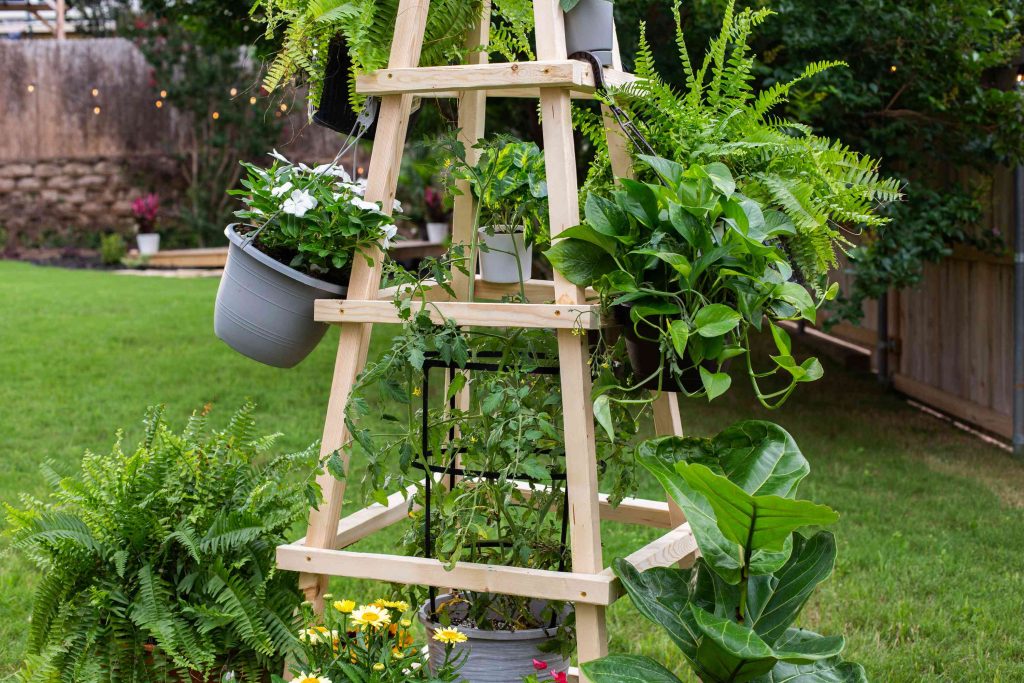This DIY obelisk garden trellis is so versatile, it can be used for all sorts of plants that love to climb and trail. You can use it as a tomato cage or as a general support for any type of plant. At the top is space for a lightweight planting pot, too.
Because the trellis is 6 feet tall, you’ll have plenty of vertical room for draping vines or spiller or trailing plants like wisteria, honeysuckle, snapdragons, or jasmine. Plants like roses that grow upward will be eager to climb the trellis, too.
DIY Trellis Basics
Though this garden obelisk trellis has a fair number of pieces, it’s actually an easy build. First, you create one side of the trellis—a ladder shape with two legs and five rungs. Once that’s done, duplicate the ladder shape for the opposite side.
Connect the two ladders with five more rungs per side and you’re done with the build.
What makes this project so easy is that there are no complicated angles to cut: Each piece of wood is square-cut.
You can build this obelisk DIY garden trellis in about an hour. Once you build one trellis, you’ve created a pattern that can be used to make more trellises.
Safety Considerations
Because the wood pieces are best cut on an electric saw, observe all safety recommendations that come with the saw.
Once the trellis is complete, be aware of tipping concerns. Though the base of the obelisk is broad, the top can still become heavy, especially if you place a planting pot at the top.
If you wish to use a pot, choose a lightweight resin, rubber, or metal pot rather than a heavy terracotta or stone-like pot. Be careful after watering, as this makes the pot heavier. If the trellis appears to be top-heavy, secure it to the ground at its base.
What You’ll Need
Equipment / Tools
- Electric miter saw or circular saw
- Drill
- Drill bits and drivers
- Paint brush
- Pencil
- Tape measure
Materials
- 8 two-by-two lumber, each 8-foot
- Wood glue
- Paint or stain
- 1 box 3-inch exterior screws
Instructions
Instructions
-
Cut the Pieces of Lumber
Cut the eight pieces of lumber to the below lengths, for a total of 24 cut pieces of wood at the end.
Quantity Length 4 72 inches 2 27 inches 2 24 inches 2 22-3/4 inches 2 19-3/4 inches 2 18-5/9 inches 2 15-5/8 inches 2 14-5/8 inches 2 11-5/8 inches 2 11 inches 2 8 inches Mark the Bottom Rung of the First Ladder
To build the first ladder, lay two of the 72-inch pieces on a flat table or surface. Measure up and mark 6 inches from the bottom as the placement point for the bottom 24-inch rung. Place a 24-inch cut piece across the two 72-inch pieces as the first rung.
Angle the Legs
With the bottom rung still in place, angle the tops of the legs toward each other. The top-left corner of the bottom rung should be flush with the outer edges of the legs.
Fasten the Bottom Rung
Pre-drill a hole for the screw, then fasten the bottom rung in place. Use only one screw per attachment point to allow the wood pieces to be adjusted.
Fasten the Top Rung
Fasten the top 8-inch rung at the very top of the legs. Again, the top corners of the rung should line up with the edges of the legs.
Check That It’s Square
The top and bottom rungs of the ladder should be parallel. Check this with the tape measure. Adjust the legs as needed.
Dry-Fit the Middle Rungs
Dry-fit the three middle rungs, spacing them evenly between the top and bottom rungs. Starting at the top and progressing downward, mark the positions with the pencil. Lay the following cuts across the two 72-inch pieces as the middle rungs, starting with the shorter piece below the 8-inch piece and moving down.
- 11 5/8-inch piece
- 15 5/8-inch piece
- 19 3/4-inch piece
Fasten the Middle Rungs
When you are satisfied with the look of the first ladder, add a dot of wood glue to each attachment point. Attach the pieces with the 3-inch screws.
Build a Second Ladder
Duplicate the previous steps to make the second ladder.
Attach Ladders on 1 Side
Position the ladders on their sides. Attach the remaining rungs so they connect the two ladders and overlap the ends of the ladder rungs. These should be at the same levels as the ladder rungs. Starting at the top and progressing downward, place the pieces in the below order:
- 11-inch piece
- 14 5/8-inch piece
- 18 5/8-inch piece
- 22 3/4 inch piece
- 27 inch piece
Attach Ladders on the Other Side
Turn the trellis over and attach the final set of rungs to the last open side, from top to bottom in the below order:
- 11-inch piece
- 14 5/8-inch piece
- 18 5/8-inch piece
- 22 3/4 inch piece
- 27 inch piece
Finish the Trellis
Stain or paint the trellis as desired. For a rustic look, leave the wood to weather on its own. Cedar is one type of wood species that naturally weathers to a silvery-gray color. Whitewood should be painted or stained and coated. Pressure-treated wood can be painted, if you wish, or you can leave it as-is.
Add Plants
The space at top will accommodate a 10-inch diameter planting pot. For smaller pots, nail or screw spacer wood blocks.
FAQ-
What are obelisk trellises used for?
Obelisk trellises are good for vining and climbing plants. They allow vines to wrap around the trellis while still providing sufficient airflow throughout to keep plants healthy.
-
How do you secure an obelisk trellis in the ground?
An easy way to secure a wooden obelisk trellis is to wrap the legs in plastic bags to protect them from water and insect damage and then bury them roughly a foot down in the ground. A trellis also can be permanently secured by placing it in holes filled with cement.
-
Do you plant a rose inside or outside an obelisk trellis?
Some people do plant roses inside an obelisk trellis; however, this can make the trellis shift or lean if the rose plant grows beyond the structure’s size. A solution is to plant the roses next to the trellis on the outside and train them to grow around the trellis.
Read the full article here














